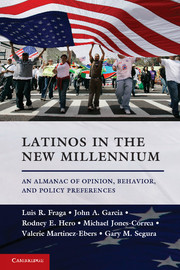Book contents
- Frontmatter
- Contents
- Acknowledgments
- 1 Latinos in the New Millennium
- 2 A Demographic Profile of Latinos in the United States
- 3 Core Values
- 4 Latino Identities
- 5 Latino Transnationalism
- 6 Intergroup Relations
- 7 Civic Engagement
- 8 Latino Media and Technology Usage
- 9 Voter Registration, Turnout, and Choice
- 10 Evolving Patterns and Preferences in Latino Partisanship
- 11 Latinos and Gender Role Attitudes
- 12 Latino Issues and Policy Preferences
- 13 Hope and Reality in Latino Educational Attainment
- 14 Latinos and the Future of American Politics
- Index
- References
2 - A Demographic Profile of Latinos in the United States
Published online by Cambridge University Press: 05 June 2012
- Frontmatter
- Contents
- Acknowledgments
- 1 Latinos in the New Millennium
- 2 A Demographic Profile of Latinos in the United States
- 3 Core Values
- 4 Latino Identities
- 5 Latino Transnationalism
- 6 Intergroup Relations
- 7 Civic Engagement
- 8 Latino Media and Technology Usage
- 9 Voter Registration, Turnout, and Choice
- 10 Evolving Patterns and Preferences in Latino Partisanship
- 11 Latinos and Gender Role Attitudes
- 12 Latino Issues and Policy Preferences
- 13 Hope and Reality in Latino Educational Attainment
- 14 Latinos and the Future of American Politics
- Index
- References
Summary
Introduction: The Changing Demographics of the Latino Community
Over the past twenty years there have been significant changes in the demographics of the Latino population in the United States. These have occurred in five areas. First, and most important, the Latino population is now much larger than previously, and it represents a larger share of the national population. The Latino population grew 58 percent between 1990 and 2000 and increased 43 percent between 2000 and 2010. The 2000 census revealed that Latinos were 12.5 percent of the U.S. population, surpassing African Americans as the largest minority group (who accounted for only 12 percent). The most recent data from the 2010 census indicate that the Latino population has grown to 16.3 percent of the U.S. population, and that trend is expected to continue for decades to come. Indeed, the Pew Research Center projects that Latinos will make up about 30 percent of the U.S. population by 2050 (Passel and Cohn 2008).
Second, we are continuing to see both immigration and native births driving Latino population growth. Immigration has increased in part as a result of expanding employment opportunities, as well as new immigration policies. The Immigration Reform and Control Act of 1986 (IRCA), for instance, regularized the immigration status of a significant number of people, many of whom were then able to sponsor additional family members to enter the country. The Illegal Immigration Reform and Immigrant Responsibility Act (IIRIRA) of 1996 had the unintended effect of encouraging undocumented migrants to remain in the country rather than risk apprehension by traveling between a home country and the United States (U.S. Commission on Immigration Reform 1997). The largest source of Latino population growth is not immigration, however, but native births. For example, from 2000 to 2006, the Latino population grew by 10.2 million, 58.6 percent of which was due to native births (Nasser 2008).
- Type
- Chapter
- Information
- Latinos in the New MillenniumAn Almanac of Opinion, Behavior, and Policy Preferences, pp. 29 - 55Publisher: Cambridge University PressPrint publication year: 2011



